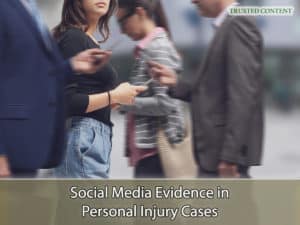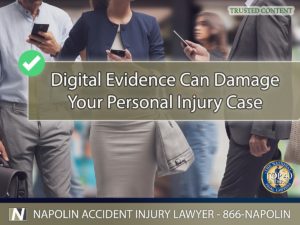How Digital Evidence Can Damage Your California Personal Injury Case
In today's digitally connected world, personal injury cases are increasingly influenced by digital evidence. From social media posts to text messages, these digital artifacts can play a crucial role in supporting or undermining a victim's claims. The prevalence of digital evidence has made it essential for individuals involved in personal injury cases to understand the implications of their online activity. Social media posts, location data, and even emails can provide crucial insights into the events surrounding an accident. However, these same pieces of evidence can also be used to contradict or diminish injury claims, especially if misinterpreted or taken out of context. This article explores how digital evidence can impact your California personal injury case and provides tips for navigating this complex terrain with the help of Napolin Accident Injury Lawyer, a trusted firm representing injury victims in southern California.
Understanding Digital Evidence in Personal Injury Cases
Digital evidence encompasses any electronic data that can be used to support or refute a legal case. In personal injury cases, common types of digital evidence include:
Social Media Posts
Photos, videos, status updates, and comments shared on social media platforms like Facebook, Instagram, and Twitter can often reveal a lot about an individual's activities, health, and overall well-being. For instance, a post showing the victim engaging in strenuous activities shortly after the injury incident can be detrimental to their claim. Defense attorneys often comb through social media accounts to find posts that contradict a plaintiff's injury claims.
Text Messages
Conversations that reveal details about the accident, injuries, or interactions with the defendant can be used as evidence. Text messages can demonstrate admissions of guilt, discuss the severity of injuries, or reveal potential witnesses. In some cases, victims may unknowingly weaken their cases by texting details that downplay their injuries or express regret over pursuing legal action.
Emails
Electronic communications that can offer insights into discussions about injuries or legal strategies. Emails between the victim and their employer, family, or healthcare provider can sometimes reveal critical information about the extent of injuries and the victim’s ability to work. Even casual emails where the victim discusses their day-to-day life could undermine their claims if interpreted negatively.
Location Data
GPS data from smartphones, apps, or wearable devices that provide insights into the victim's movements. For instance, location data showing the victim engaging in activities inconsistent with their injury claims can be used against them in court. Apps like Google Maps and Apple Health often record extensive location history, which can either support or contradict the victim's testimony.
Other Digital Evidence
Traffic camera footage, surveillance videos, and vehicle event data recorders (black boxes) can all provide valuable evidence in personal injury cases. Surveillance footage from nearby businesses or traffic cameras can corroborate the victim’s version of events. Black boxes in vehicles record crucial information like speed, braking, and seatbelt usage before a collision.

Social Media Evidence in Personal Injury Cases
Social Media Evidence in Personal Injury Cases
Social media evidence has become increasingly relevant in personal injury cases. Photos, status updates, and comments can contradict a victim's injury claims or reveal pre-existing conditions. Common platforms involved include Facebook, Instagram, and Twitter. Here’s how social media can impact injury claims:
Contradicting Claims
Photos or videos showing the victim engaging in physical activities that contradict their injury claims can weaken their case. For instance, if the plaintiff claims they cannot walk due to a leg injury but posts a picture of themselves hiking, it may be used as evidence against them.
Revealing Pre-Existing Injuries
Past posts or updates that show prior injuries may suggest the victim’s current condition is unrelated to the accident. Defense attorneys may use these posts to argue that the plaintiff's current injuries are part of a pre-existing condition and not related to the incident in question.
Inconsistent Statements
Comments or status updates that differ from the victim's testimony can raise doubts about the credibility of their claims. For example, if a plaintiff testifies that their injury prevents them from enjoying social outings but posts updates about attending parties, it can create inconsistencies in their story.
Tagging and Third-Party Posts
Even if the victim exercises caution in their posts, they can still be tagged by friends or appear in third-party posts, which might reveal activities inconsistent with their claims. A friend tagging the victim in a post about a recent sports game or dance party can provide evidence against them.
Direct Messages
Private messages on social media platforms can also be subpoenaed and reviewed for evidence. Conversations where the plaintiff discusses their injuries or legal strategy with friends could weaken their case if not handled carefully.
Privacy Settings
Privacy settings on social media platforms are often insufficient to protect the plaintiff’s information. Defense attorneys can still access private posts through legal means or by creating fake accounts to befriend the plaintiff.
Best Practices for Injured Victims Using Social Media
- Avoid posting about the accident or injuries.
- Set social media accounts to private.
- Be cautious about accepting new friend requests.
- Review past posts for potential inconsistencies.
- Disable location services to prevent GPS tagging.
- Inform friends and family to avoid tagging or mentioning you in posts.
Text Messages and Emails as Evidence
Text messages and emails can provide valuable insights into personal injury cases. Relevant communications might include:
Conversations with the Defendant
Discussions with the party at fault that could reveal admissions of guilt or responsibility. For example, a text where the defendant apologizes for their role in the accident can significantly strengthen the victim’s case. Even casual texts expressing concern for the victim’s well-being can be interpreted as admissions of guilt.
Discussions of Injuries
Messages detailing the extent of injuries, pain, or treatments. Plaintiffs who minimize their injuries in texts to friends or family might inadvertently weaken their case.
Legal Strategies
Emails between the victim and legal team that could inadvertently weaken the case. For instance, discussing potential settlement amounts or expressing uncertainty about pursuing legal action could be damaging if revealed.
Work-Related Emails
Emails to and from employers regarding the victim's ability to work can offer critical insights into the plaintiff’s condition. For instance, emails requesting medical leave or modified work schedules could support the injury claim.
Medical Correspondence
Emails with healthcare providers can reveal details about the victim’s injuries, treatments, and recovery progress. These emails could be used to confirm or dispute medical records presented in court.
Third-Party Communications
Text messages or emails with friends, family, or colleagues discussing the accident can provide further evidence of the victim's injuries and condition.
How Text Messages and Emails Can Be Subpoenaed
Digital communications can be subpoenaed through a court order, compelling the parties involved to provide relevant data. The subpoena process requires demonstrating the relevance of the data to the case. Once granted, service providers or individuals must comply and provide the requested information.
Importance of Preserving Communications
Victims should preserve all relevant text messages and emails to avoid spoliation of evidence, which could lead to negative inferences in court. Here are some best practices for preserving communications:
- Avoid deleting any texts or emails related to the case.
- Regularly back up digital communications to prevent accidental loss.
- Inform friends and family about the importance of preserving their messages.
- Take screenshots of important conversations to maintain a backup.
- Consult with legal counsel before sharing or discussing case details via text or email.
Location Data and Other Digital Evidence
Location data and other forms of digital evidence can play a significant role in personal injury cases. Here’s how:
GPS and Location Data
Smartphone apps and wearable devices often track GPS data, providing insights into the victim's movements. For instance, Google Maps records a detailed location history that can show the victim’s exact whereabouts at any given time. This data can corroborate the victim’s story or reveal activities inconsistent with their claims.
Wearable Devices
Fitness trackers and smartwatches can reveal activity levels before and after the accident. Data from devices like Fitbit and Apple Watch can show the victim’s step count, heart rate, and activity levels, which could be used to challenge their injury claims.
Traffic Camera Footage
Surveillance videos and traffic cameras can corroborate the victim’s version of events. Footage from nearby businesses or traffic lights can provide critical evidence about how the accident occurred and who was at fault.
Vehicle Event Data Recorders
Black boxes in vehicles record crucial information like speed, braking, and seatbelt usage before a collision. This data can reveal whether the victim was speeding or wearing a seatbelt, which could impact the determination of fault.
Surveillance Videos
Footage from security cameras at businesses, residences, or public areas can offer additional evidence about the accident. For instance, a camera at a nearby gas station might capture the entire incident.
Dashcam Videos
Dashcam footage from the victim’s or other vehicles can provide a first-hand account of the accident.

Legal Considerations for Digital Evidence in California
Legal Considerations for Digital Evidence in California
California law governs the admissibility of digital evidence in personal injury cases. Here are some key considerations:
Admissibility in Court
Digital evidence must be relevant, authentic, and not overly prejudicial to be admitted in court. The plaintiff must demonstrate that the evidence is directly related to the case and has not been tampered with or altered.
Privacy Issues and Challenges
Privacy concerns can arise when subpoenaing digital data, requiring a balance between privacy rights and the need for evidence. For instance, obtaining a defendant's private messages may violate their privacy rights if not handled properly.
California Laws Governing Digital Evidence
California’s Electronic Communications Privacy Act (CalECPA) provides protections against unauthorized access to electronic data. Law enforcement and legal teams must obtain a warrant or subpoena to access private electronic communications.
Authentication Requirements
The plaintiff must authenticate digital evidence by proving its origin and that it has not been tampered with. This can involve obtaining testimony from individuals involved or experts who can verify the data’s integrity.
Chain of Custody
Maintaining a clear chain of custody is essential for the admissibility of digital evidence. This involves documenting every individual who handled the evidence and any changes made to it.
Hearsay and Prejudicial Concerns
Digital evidence may be excluded if it constitutes hearsay or is overly prejudicial. For instance, comments made in private conversations that lack context could be considered hearsay.
Challenges and Limitations of Digital Evidence
Digital evidence presents several challenges and limitations:
Authenticity and Reliability Concerns
Ensuring the evidence has not been tampered with or altered is crucial for its reliability. For instance, a doctored screenshot or edited video could misrepresent the events in question. Verifying the source and integrity of digital evidence often requires expert analysis.
Preservation and Spoliation of Evidence
Failing to preserve digital evidence or intentionally destroying it can lead to negative inferences. Courts may assume that the destroyed evidence would have been unfavorable to the party responsible for its spoliation.
Overcoming Objections to Admissibility
Objections can include claims of hearsay, irrelevance, or prejudice. Legal teams must prepare to counter these objections with clear arguments and supporting evidence.
Privacy and Data Protection Issues
Accessing private electronic data can raise significant privacy concerns. Courts must balance the need for evidence with the individual's right to privacy, which can complicate obtaining digital communications.
Volume of Data
The sheer volume of digital evidence can overwhelm legal teams, making it difficult to identify relevant information. This is particularly true with social media data, where thousands of posts and comments may need to be reviewed.
Technical Expertise
Analyzing digital evidence often requires technical expertise in data retrieval, forensics, and cybersecurity. Plaintiffs may need to consult with experts to authenticate and interpret the data effectively.

How Digital Evidence Can Damage Your California Personal Injury Case
How Digital Evidence Can Damage Your California Personal Injury Case
Digital evidence can significantly impact the outcome of a California personal injury case, either strengthening or damaging a victim's claims. Napolin Accident Injury Lawyer, with its extensive litigation experience and personalized approach, is committed to securing the best outcome for injured victims. If you've been injured and need legal help, call (866)-NAPOLIN for a free consultation. The firm offers representation across southern California, with no fees unless the client wins. Whether you need assistance staying mindful of social media evidence, text messages, or GPS data, Napolin Accident Injury Lawyer is equipped to handle your case with precision and care.
- Understanding Uber Accidents and Insurance Coverage Periods in California - April 8, 2025
- A Guide on Red Light Auto Accidents in California - August 14, 2024
- Self-Representing in a California Personal Injury Claim - August 13, 2024
